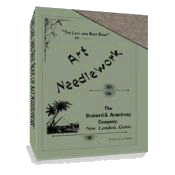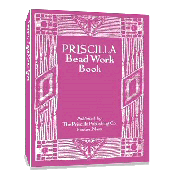Botanical Stitches to Try
Botanical stitches have been used since the beginning of the craft known as embroidery. Amazing pieces of artwork have been and can be created with little effort if care is taken to make your stitches correctly and neatly. The sky (and your imagination) is the limit to how these stitches can be combined. And colors! Think of all the colors and color combinations you could use for these stitches! Let your imagination soar and give at last a few a try.
Below you will find a number of illustrations of flowers and other botanical stitches that just may provide you with inspiration for your next embroidery piece.
Create Beautiful Flowers
Flower in Satin Stitch | Rose in Satin Stitch | Petal for Rose | Heartsease | Raised Flower | Ear of Corn | Bluebell | Flower in point de Minute | Flowers in Applique |
ILLUSTRATION 107. (Flower in Satin Stitch).--The fine veinings are worked with fine black silk in point russe, which renders the effect of the flower very beautiful.

ILLUSTRATIONS 108 & 109 (Rose in Satin Stitch).--No. 109 shows one petal larger than full size. The outer circle only is prepared with chain stitches underneath, so as to appear raised; the inner circles are worked flat. The centre of the rose is embroidered in open work


ILLUSTRATION 110 (Embroidered Heartsease).--For the knotted stitch see No. 75. For the point croisé see 71 and 72.


ILLUSTRATION 112 (An Ear of Corn in Point de Minute).

ILLUSTRATIONS 113, 114, & 116 (Bluebell in Raised Satin Stitch).--This flower is worked partly in separate pieces, as has been described. Illustration 116 shows the raised part stretched out flat. When it is finished it is fastened down along the dotted line on No. 114, which shows the inner part of the flower.

ILLUSTRATION 115 (Flower in Point de Minute).--This stitch is here worked over a thick foundation of chain stitches. For raised patterns it looks very well.

Botanical Stitches - Flower in Appliqué
ILLUSTRATIONS 116 & 117 (Flower worked in Appliqué).--To work in appliqué, two materials, either similar or different, are needed. You can work either in appliqué of muslin on muslin, or of muslin on net, or of net on net. Muslin on Brussels net is the prettiest way of working in appliqué; we will therefore describe it: the other materials are worked in the same manner. Trace the pattern on the muslin, fasten the latter on the net, and trace the outlines of the pattern with very small stitches work them in overcast stitch with very fine cotton, taking care not to pucker the material. The veinings are worked in overcast. When the pattern has been embroidered cut away the muslin round the outlines with sharp scissors, so that the net forms the grounding (see No. 117). The greatest care is required in cutting out the muslin to avoid touching the threads of the net.


The number of botanical embroidery stitches is countless. Mother Nature inspires all who create with fancy needlework. Although these botanical stitches were used during Victorian times, their usefulness is as apparent today as it was then.
Borders and Insertions has illustrations of some very useful and decorative stitches to add just that extra special touch to your project.
The information provided above is from Beeton's Book of Needlework and edited for use on this site.
Return to Embroidery Stitches.
The Last and Best Book of Art Needlework
Over 100 pages of authentic Victorian instructions and patterns from 1895!
FREE
Beeton's Book Of Needlework

433 pages!
Sign up for VEAC! Everything you wanted to know about Victorian embroidery, needlework, crafts and more!
Priscilla Bead Work Book
Make Beautiful Victorian Beaded Purses, Jewelry & Accessories - Starting
TODAY!



